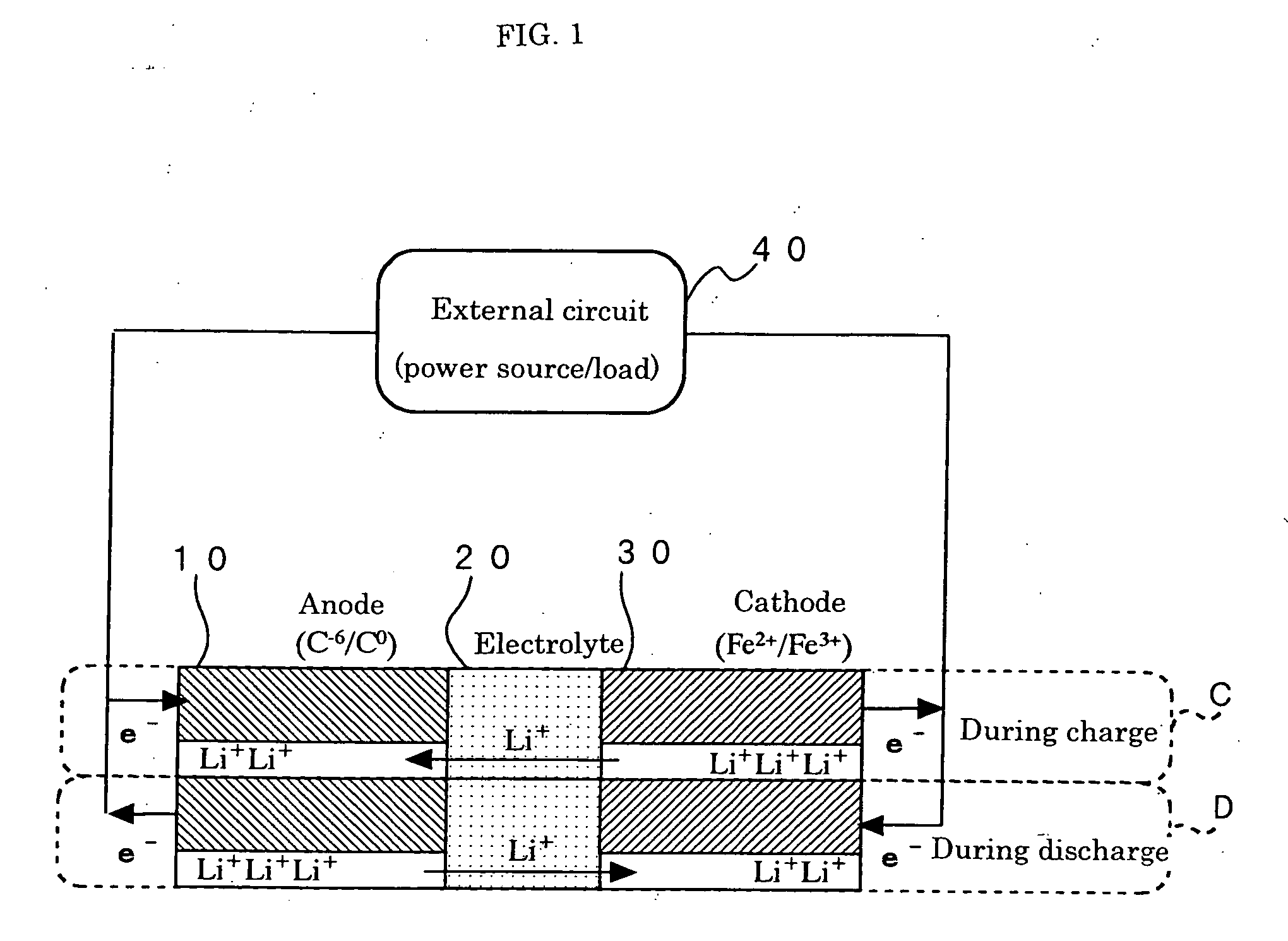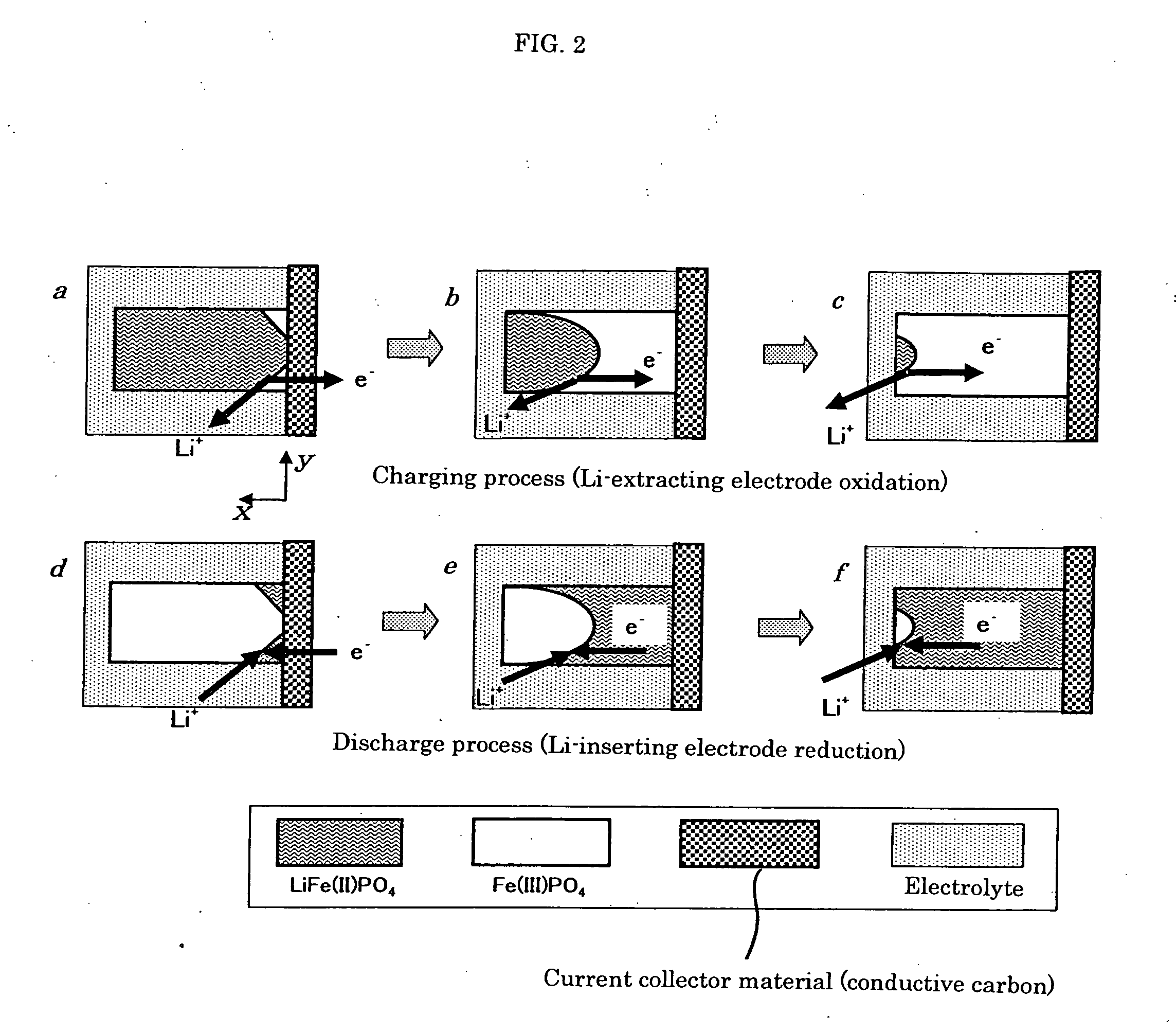Cathode Material For Secondary Battery, Method For Producing Same, and Secondary Battery
a secondary battery and cathode material technology, applied in the direction of cell components, electrochemical generators, transportation and packaging, etc., can solve the problems of small effective capacity, bad rate characteristics, and inability to obtain bad cycle characteristics, and achieve excellent charge/discharge behaviors, high conductivity, and easy production.
- Summary
- Abstract
- Description
- Claims
- Application Information
AI Technical Summary
Benefits of technology
Problems solved by technology
Method used
Image
Examples
example 1
(1) Preparation of Cathode Material
[0095]An Mo composite LiFePO4 cathode material was synthesized by the following procedure.
[0096]A mixture of 4.4975 g of FeC2O4.2H2O (product of Wako Pure Chemical Industries, Ltd), 3.3015 g of (NH4)2HPO4 (special grade; product of Wako Pure Chemical Industries, Ltd), and 1.0423 g of LiOH.H2O (special grade; product of Wako Pure Chemical Industries, Ltd) was mixed with a volume of ethanol about 1.5 times that of the mixture. The resulting mixture was pulverized and stirred in a planetary ball mill with 2 mm zirconia beads and a zirconia pot for 1.5 hours and dried at 50° C. under reduced pressure. The dried mixture was mixed with 0.1366 g (which corresponds to 2 mol %, in terms of element ratio, based on Fe in FeC2O4.2H2O) of molybdenum pentachloride MoCl5 (product of Wako Pure Chemical Industries, Ltd), and the resulting mixture was ground and stirred in an automatic agate mortar for 1.5 hours to obtain a calcination precursor. The calcination pre...
example 2
[0104]The ingredients were mixed at the same ratio as in Example 1 and synthesized into a Mo composite cathode material by the same procedure as in Example 1. A cathode film coated sheet, which is more practical than a pellet type cathode as described above, was prepared using the composite cathode material by the following procedure, and the characteristics of the lithium secondary battery were evaluated.
[0105]The particle size of the 2 mol % Mo composite cathode material powder was adjusted with a 45 μm mesh sieve. The cathode material, acetylene black [Denka Black (registered trademark), product of Denki Kagaku Kogyo K.K.; 50% pressed product] as a conductivity-imparting material and a 12% polyvinylidene fluoride (PVDF) / N-methyl pyrrolidone (NMP) solution (product of Kureha Chemical Industry Co., Ltd.) were mixed at a ratio by weight of 85:5:10 (as PVDF). N-methylpyrrolidone (NMP) (water content: less than 50 ppm, product of Wako Pure Chemical Industries, Ltd.) was added to adjus...
example 3
[0108]The same procedure as in Example 1 was repeated except that the amount of MoCl5 added was decreased to 0.0683 g, a half of that used in Example 1, and the final calcination period was shortened to 10 hours to prepare a 1 mol % Mo composite LiFePO4 cathode material as opposed to the 2 mol % Mo composite cathode material of Example 1. A coin-type battery was fabricated using the cathode material in the same manner as in Example 1, and the characteristics of the battery were evaluated.
[0109]The battery was repeatedly charged and discharged in an operating voltage range of 3.0 to 4.0 V at 25° C. and a current density of 0.5 mA / cm2 per apparent area of the cathode pellet. The discharge capacities of the battery in the first, tenth and twentieth cycles are shown in Table 3. In this example, a two-stage curve of the charge / discharge voltage with the progress of the cycles as described before was not observed.
[0110]In the following Comparative Examples 2 to 10, the characteristics in ...
PUM
 Login to View More
Login to View More Abstract
Description
Claims
Application Information
 Login to View More
Login to View More - R&D
- Intellectual Property
- Life Sciences
- Materials
- Tech Scout
- Unparalleled Data Quality
- Higher Quality Content
- 60% Fewer Hallucinations
Browse by: Latest US Patents, China's latest patents, Technical Efficacy Thesaurus, Application Domain, Technology Topic, Popular Technical Reports.
© 2025 PatSnap. All rights reserved.Legal|Privacy policy|Modern Slavery Act Transparency Statement|Sitemap|About US| Contact US: help@patsnap.com



